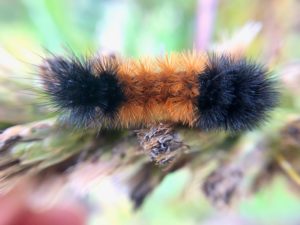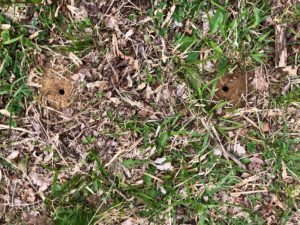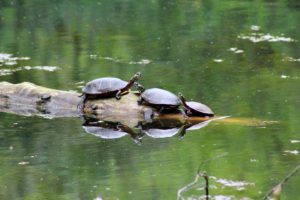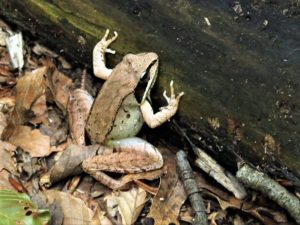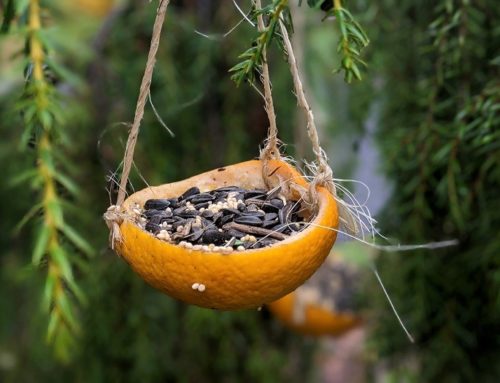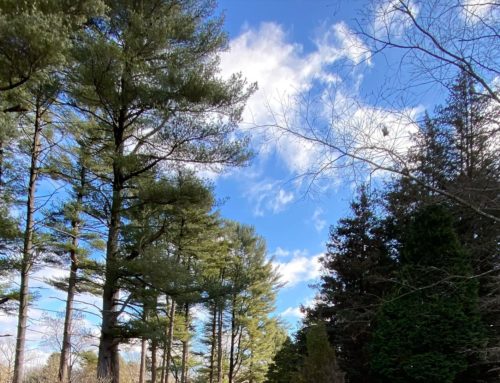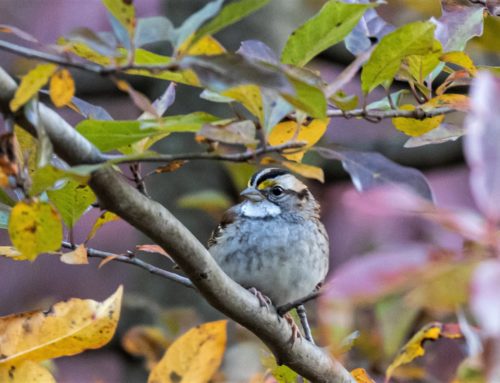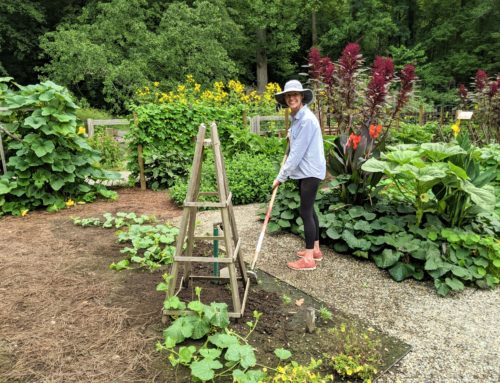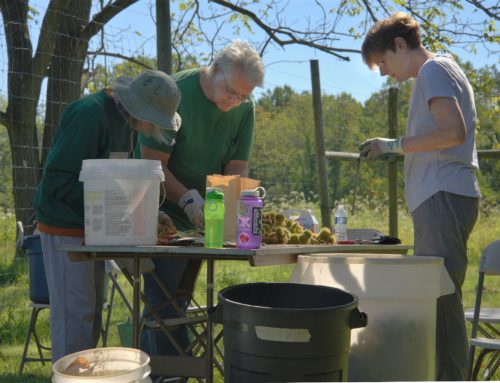Come December, the temperature drops, the cold winter wind begins to smell of snow, and the dark hours stretch for more than half the day. It is a season to find shelter, to hunker down, and keep warm. For us, our homes become places of comfort — a radiator where we can dry our winter-wet boots, a window where we can watch the snowfall. But what about our neighbors, the birds, insects, and other wildlife who shelter through the winter months with us? Let’s find out some of the strategies they use to keep warm.
Insects – By Nancy Heinbaugh
We hear the phrase ‘leave the leaves’ when October comes around each year. As a homeowner, many of us like our property to be tidy as we prepare our gardens for winter. We spend hours cutting back our plants, raking or blowing out the leaves, and leaving just soil or a thin layer of mulch in our garden beds. Is this the best decision for our plants and native insects, though? Observing nature and doing some research is a great way to get some answers to our garden questions.
Throughout October, sightings of wooly bear caterpillars (Pyrrharctia isabella) were frequent if you were outside. They had reached their final growth stage and began to wander, searching for a prime winter location, somewhere cool and dark, usually under fallen leaves, which becomes an insulating blanket covered by snow and ice. Hibernating bumblebee queens and the larvae of many butterflies and other moth species also seek out this same environment for the winter months. Let’s not forget the lady beetles seeking leaves and debris for the winter, ready to devour the first aphids of spring.
Shredding these leaves will also shred the caterpillars and insects. Even if some survive, the leaves will now mat together from the rain and snow, no longer offering crevices for survival. Blowing the leaves away could expose the insects to a harsher environment, whether it is the warm sun causing repeated freezes and thaws or colder temperatures than they can withstand. Leaves naturally fall everywhere, often ending up in corners and amongst other plants. Removing the leaves removes the insect’s homes. Even allowing a small area of leafy debris on your property will help these insects survive the winter.
Some areas of bare soil can be left for ground-nesting bees, often spotted in late winter or early spring in undisturbed soil. These bees are very docile and fantastic pollinators. They prefer south-facing sandy soil. We have added a few areas of this habitat to Tyler’s Pollinator Preserve in hopes of attracting these pollinators. You may unknowingly walk right past them, but try training your eyes to look for the small openings in the soil, similar to an anthill but with a larger hole. If you are lucky enough to have some native bees, try to leave 6″- 8” between their nests and any digging you might do, allowing them to raise their broods.
There are dozens of other wintering sites for insects. There are swallowtail butterfly chrysalides and cecropia moth cocoons nestled against the plant stems and trees in the Butterfly House, while the mourning cloak butterfly tucks itself into crevices in trees or cracks in rocks. The dragonfly nymphs in Tyler’s pond live beneath the ice, while Japanese beetle grubs dig deeply into the soil to await the signal of spring’s temperatures. The praying mantis egg cases (ootheca) are easily noticed in Tyler’s meadows.
But what about some larger critters? Let’s take a walk down to Tyler’s Pond to see who might be taking shelter in its chilly waters and deep mud.
Turtles – By Louisa Romaine
In the summer, when I visit the pond at Tyler, I always look for turtles. Sometimes I can spot one swimming, its head just breaking the surface of the water before it disappears. But more likely, there are several painted turtles of all sizes resting on a few logs that lay above the waterline. Visitors to Tyler have also seen snapping turtles and red-eared sliders (not native to our area) in the pond. As the weather turns colder, the turtles are nowhere to be seen. It turns out that turtles have ingenious ways of coping with the cold.
As reptiles, turtles are endothermic, getting heat from their environment instead of generating it as mammals and birds do. As the air and water become cooler, turtles become less active and use less oxygen.
Both painted turtles and snapping turtles spend the winter in ponds under the ice, buried in mud. They can switch their metabolism to one that does not require oxygen. Turtles have lungs and breathe air in warmer weather. But when they are submerged in the winter, they can absorb some oxygen through their mouth, skin, and cloaca. You read that correctly. They can breathe through their butts! Because their metabolism is reduced by about 90%, they can survive with no food and little oxygen. The turtles are not asleep and will occasionally move while under the ice. While getting oxygen from the water in winter helps turtles survive, it results in a buildup of lactic acid, damaging the turtle’s shell and skeleton. By spring, the turtles are anxious to increase their metabolism by sitting in the sun, ridding themselves of the lactic acid. As the water becomes warmer and more light reaches the pond, the turtles become more active, resuming eating and breathing through their lungs.
Frogs – By Bess Trout
Aquatic frogs, like the American bullfrog (Rana catesbeiana), spend their winter months on the bottom of ponds. Frogs need to be near the oxygen-rich water to survive. They hibernate, slowing their bodies way down so that they can survive without finding food for months at a time. If the water is clear, you might see them remaining quiet against the mud or swimming very slowly along the pond bottom.
Land-dwelling frogs have a different adaptive strategy. American toads (Bufo americanus) are accomplished diggers and spend their winters buried deep in the soil, well below the frost line. But not all frogs can dig so deep! Some of our earliest spring risers, the wood frogs (Rana sylvatica) and spring peepers (Hyla crucifer), tuck themselves into cracks and fissures in logs, trees, and rocks, or burrow into the leaf litter on the forest floor. These spaces are less insulated than the muddy beds of the other terrestrial frogs, and sometimes the temperatures will get so cold that these spaces – and the frogs within them – will freeze solid. When that happens, ice crystals will form inside these frogs, they will stop breathing, and their hearts will stop beating. They will appear dead. But, high glucose levels will keep these essential organs from freezing, and when temperatures warm, these frogs will thaw and come back to life. Early March and into April, visitors can hear wood frogs and spring peepers singing in the vernal ponds around Tyler’s Scenic Loop.
Birds – By David Eberly
But what about our feathered neighbors – the birds? Most bird species survive the northern winter by escaping it. This is a simple strategy, but not without its dangers. Those species that stay north have developed several adaptive strategies to survive a long cold winter.
Shelter is, of course, necessary. Woodpeckers excavate roosting cavities which are separate from their nesting cavities. Ruffed Grouse shelter in snow dens. Some species put themselves in a deep state of torpor overnight, bringing their body temperatures to just above freezing. Crows and other species huddle together in large communal roosts.
Golden-crowned Kinglets offer a story that is both improbable and inspiring as an example of community benefits to the survival of severe adverse conditions. These birds of coniferous forests, half the weight of a chickadee, rely almost exclusively on insects, not exactly abundant in winter, for food. Although most migrate to somewhat warmer climes, many overwinter in the northern Appalachians. They have been seen in the Maine woods at -30°F. Like several bird species, Golden-crowned Kinglets forage in small flocks, which provides more eyes for locating sparse food. Bernd Heinrich, a noted researcher of birds, insects, and the northern forests, wondered how these tiny critters survive a cold winter night. Was it torpor? Do they use a cavity? He used a very simple research technique. One dark winter night in Maine, he observed a group of four Golden-crowned Kinglets disappear into a pine tree. With a flashlight in hand, he carefully climbed the tree and discovered four kinglets huddled together on a limb deep inside the pine, sharing each other’s body heat. Each tiny little bird depends on the other for food, shelter, and survival.
As humans, we spend the winter tucked in our warm houses, kept snug by our heating systems and our coziest sweaters. But all around us, wildlife is surviving as well. So as you move through the winter landscape, consider who you might be passing by, the native bees in the soil of your vegetable garden, waiting for the ground to warm so they can fly forth to pollinate next summer’s tomatoes.; Or perhaps the spring peeper tucked in your leaf pile, who will wake when warmed by the sun to sing in the spring, or the birds that land on your feeders for a snack before winging home to their pine trees. Let’s take care of one another as the cold days go by and we shelter together through another winter season.


